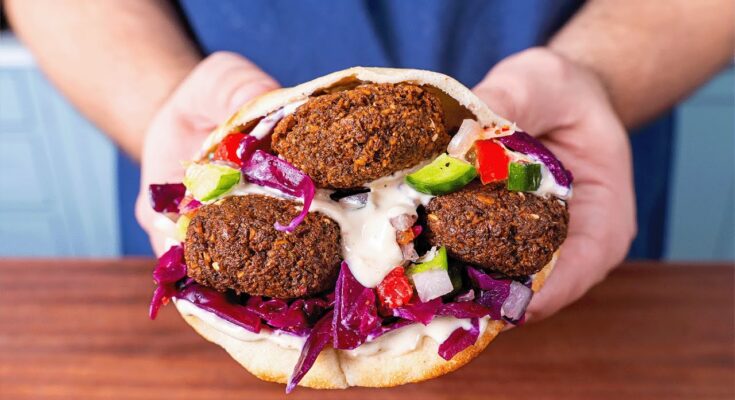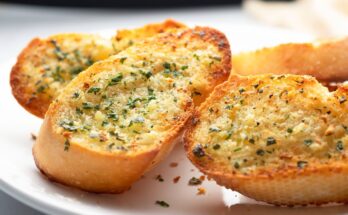Falafel Recipe: Falafel is a beloved Middle Eastern dish, known for its crispy exterior and soft, flavorful interior. These deep-fried or baked balls or patties are usually made from ground chickpeas or fava beans mixed with herbs and spices.
With its origins rooted in Egypt, falafel has spread across the globe, becoming a street food staple in countries like Israel, Lebanon, and beyond.
Whether enjoyed in pita bread, alongside salads, or as part of a mezze platter, falafel brings together rich flavors with a satisfying crunch.
Ingredients for Homemade Falafel
A great falafel starts with simple yet flavorful ingredients.
Key Ingredients
- Chickpeas: The star ingredient, providing texture and taste. Opt for dried chickpeas for the best results.
- Fresh Herbs: Parsley, cilantro, and mint add freshness to the mix.
- Spices: Cumin, coriander, salt, and black pepper infuse earthy, warm flavors.
- Baking Soda: Helps lighten the mixture for a fluffier texture.
Optional Ingredients for Variations
- Onions and Garlic: These add more depth to the flavor.
- Sesame Seeds: Roll the falafel in sesame seeds for added crunch.
- Chili Flakes: Perfect for those who like a little kick.
Essential Kitchen Tools for Falafel
- Food Processor: Essential for blending the chickpeas and herbs.
- Mixing Bowls: To combine and chill the mixture.
- Frying Pan or Air Fryer: Depending on your cooking method.
- Tongs or Slotted Spoon: Handy for removing falafel from hot oil.
Preparing the Chickpeas for Falafel Mixture
While canned chickpeas are convenient, using dried chickpeas gives the best texture. Soak the chickpeas for at least 12 hours to soften them and prevent crumbling during frying. Avoid boiling the chickpeas, as this can make the mixture too mushy.
Step-by-Step Process of Making Falafel Mixture
Blending the Ingredients in a Food Processor
Combine the soaked chickpeas, herbs, garlic, spices, and baking soda in a food processor. Pulse until the mixture holds together but retains some texture.
Achieving the Right Texture
The mixture should be slightly coarse, not a smooth paste. This ensures the falafel will stay together when fried and have the perfect crunch.
Shaping the Falafel Balls or Patties
Using your hands or a falafel scoop, form the mixture into small balls or patties. Aim for a size slightly smaller than a golf ball to ensure even cooking.
Cooking Methods for Falafel
Traditional Deep-Frying Method
Heat oil to around 350°F (175°C) in a deep pan. Carefully drop the falafel balls in the hot oil and fry for 3-4 minutes until golden brown. Use a slotted spoon to transfer them to a plate lined with paper towels.
Air-Frying or Baking for a Healthier Option
If you prefer a healthier version, air-fry the falafel at 370°F (190°C) for 12-15 minutes, flipping halfway through. Alternatively, bake them at 400°F (200°C) for 20-25 minutes until crisp.
Tips for Crispy and Fluffy Falafel Every Time
- Add baking soda to the mixture to lighten the texture.
- Chill the mixture for at least 30 minutes before shaping to prevent crumbling during frying.
Serving Suggestions for Falafel
Traditional Ways to Serve Falafel
Serve your falafel wrapped in warm pita bread with a drizzle of tahini sauce. Add sliced cucumbers, tomatoes, and pickled vegetables for a classic falafel sandwich.
Modern Serving Ideas
Create falafel bowls with quinoa, hummus, and a variety of salads for a trendy, healthy meal. Or stuff falafel into wraps with avocado and sriracha mayo for a fusion twist.
Storing and Reheating Falafel
Store leftover falafel in an airtight container in the refrigerator for up to five days. Reheat in an oven or air fryer to restore crispiness.
Common Mistakes to Avoid
- Over-blending the mixture can make the falafel dense.
- Skipping the chilling step may cause falafel to fall apart in the oil.
- Using canned chickpeas without thoroughly draining them results in a soggy mixture.
Health Benefits of Falafel
Falafel is rich in protein, fiber, and essential nutrients from chickpeas. It’s also vegan, gluten-free, and full of antioxidants from herbs and spices.
Falafel Recipe Variations from Around the World
- Egyptian Ta’ameya: Uses fava beans instead of chickpeas.
- Spicy Tunisian Falafel: Infused with harissa paste for a bold flavor.
- Green Falafel: Packed with extra herbs for a vibrant color.
FAQs about Falafel Recipe
1. What is falafel made of?
Falafel is a deep-fried ball or patty traditionally made from ground chickpeas or fava beans, mixed with herbs like parsley, cilantro, garlic, cumin, and coriander.
2. Is falafel healthy?
Yes, falafel can be a nutritious option, especially when baked instead of fried. It is high in plant-based protein and fiber, making it a popular choice for vegetarians and vegans.
3. Can I bake falafel instead of frying it?
Absolutely! Baking falafel is a healthier alternative. Simply shape the mixture into patties, brush with oil, and bake at 375°F (190°C) for 20-25 minutes, flipping halfway through.
4. How do I keep falafel from falling apart?
To prevent falafel from crumbling, ensure the mixture is not too wet. Draining canned chickpeas or soaking dry beans thoroughly helps, and adding a bit of flour or breadcrumbs can improve binding.
5. Can falafel be frozen?
Yes, you can freeze uncooked falafel balls or patties. Place them on a baking sheet to freeze individually, then transfer them to an airtight container for up to 3 months.
6. What sauces go well with falafel?
Falafel pairs well with tahini sauce, hummus, garlic yogurt sauce, or a fresh tzatziki dip. These condiments enhance the flavors and add creaminess to your falafel dishes.
7. What can I serve with falafel?
Falafel is versatile and can be enjoyed in pita bread, salads, wraps, or alongside rice, couscous, or roasted vegetables. Don’t forget a side of fresh veggies for a complete meal!
Conclusion
Making falafel at home is easier than it seems. With just a few simple ingredients, you can create crispy, flavorful falafel that rivals any restaurant. Whether you deep-fry or air-fry them, serve them in pita or in a bowl, falafel is a versatile dish that’s perfect for any occasion.
References
To ensure accuracy and provide additional insights, we’ve cited reputable sources for further reading and validation of the information in this Falafel Recipe. Explore these resources to deepen your understanding or discover variations and expert tips:
- AllRecipes – A popular resource with comprehensive falafel recipes and user reviews.
- BBC Good Food – Offers authentic Mediterranean recipes with detailed cooking tips.
- Food Network – Features chef-curated falafel variations and instructional videos.
- Epicurious – Provides unique takes on traditional falafel with nutrition insights.
- Bon Appétit – Delivers professional advice and creative twists on falafel dishes.
These sources offer a blend of traditional and modern falafel interpretations, helping you perfect your recipe while exploring new flavors.



